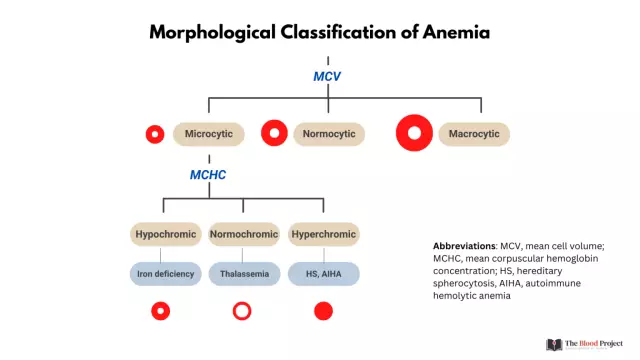- Author Curtis Blomfield [email protected].
- Public 2023-12-16 20:44.
- Last modified 2025-01-23 17:01.
Anemia is a syndrome characterized by low levels (compared to the norm) of hemoglobin in the blood, and not only the total value, but its amount in one erythrocyte is taken into account.

Hemoglobin function and its norms
Hemoglobin is a protein that has an iron atom in its composition, capable of binding oxygen molecules. It is found only in red blood cells. Outside these cells, this protein is rapidly degraded. Normal indicators are considered to be an interval from 110 to 155 g per liter (for women - 110-145, and for men - 120-155). A drop below 110 is anemia. The fact is that hemoglobin from 110 to 120 in men is considered the maximum allowable, although not normal.
Degrees of anemia
Clinical practice has shown that a decrease in the level of this protein to different numbers has similar manifestations, which is why all anemias are usually divided into several groups. Previously, there was a classification according to the severity - light, medium and heavy. Now it has been decided to name these degrees in numerical order in ascending order. So anemia of the 1st degree is considered the least severe. Hemoglobin with her ranges from 110 to 90 and usually she has no clinical signs under normal living conditions. Anemia of this degree of blood showshimself only when performing certain loads that go beyond the usual for a given person. The first signs that appear during normal exercise correspond to anemia of moderate severity. Now it is called the second. With it, hemoglobin ranges from 90 to 70 g in one liter of blood. Finally, severe anemia (now called the third) is characterized by a detailed picture of the disease. Here hemoglobin numbers are below 70.
Causes and forms of the disease
The causes leading to the development of the disease determine its form.
1. Severe anemia. They are always associated with a rapid loss of red blood cells. There are two reasons for this: bleeding and the rapid destruction of red blood cells. The latter circumstance is observed, for example, in case of poisoning with hemolytic poisons. A rapid decrease in the level of hemoglobin exceeds the rate of development of the body's compensatory capabilities. Therefore, grade 1 anemia can occur even at rest.

2. Chronic anemia accounts for more than 80-85% of all diseases of this type, so their causes are the most common. These are a number of diseases, for example, a deficiency of any factor at any stage of hemoglobin synthesis, pathology of the structure of erythrocytes and their diseases. Deficiency factors include lack of iron, cyanocobalamin, cytochromes, porphyrin. Pathology of erythrocytes can be congenital or acquired. In the first case, erythrocytes are either formed with defects leading to a decrease in the level of hemoglobin in them, or they themselves are very unstable andprone to rapid destruction. Often, the first signs appear even when a person has grade 1 anemia. Acquired pathology occurs as a result of various diseases leading to the early destruction of red blood cells. One example is malaria.
Clinical manifestations of chronic anemia
Regardless of the level of hemoglobin, chronic anemia, the severity of which is determined only by the severity of manifestations, has a certain set of symptoms.
Weakness and fatigue.
· Dizziness, tinnitus and flashing "flies" before the eyes.
Pale skin.

Brittleness of nails, change in their shape and color.
· Dry skin and hair loss.
All of these signs are optional for one person. So, anemia of the 1st degree in some can manifest itself only with pallor and dry skin, while others may experience brittle nails and hair loss with normal skin color.
Prevalence of anemia among surgical diseases
The problem of anemia is not only therapeutic, a small percentage of its cases occur in surgical practice. And often anemia is the first sign of any pathology that requires emergency intervention by a surgeon. One of the most common such conditions is bleeding from the organs of the digestive tube.






